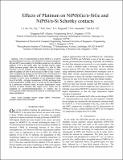Effects of Platinum on NiPtSiGe/n-SiGe and NiPtSi/n-Si Schottky Contacts
Author(s)
Jin, Lijuan; Pey, Kin Leong; Choi, Wee Kiong; Fitzgerald, Eugene A.; Antoniadis, Dimitri A.; Chi, D.Z.; ... Show more Show less
DownloadAMMNS005.pdf (370.8Kb)
Metadata
Show full item recordAbstract
Solid phase reaction of NiPt/Si and NiPt/SiGe is one of the key issues for silicide (germanosilicide) technology. Especially, the NiPtSiGe, in which four elements are involved, is a very complex system. As a result, a detailed study is necessary for the interfacial reaction between NiPt alloy film and SiGe substrate. Besides using traditional material characterization techniques, characterization of Schottky diode is a good measure to detect the interface imperfections or defects, which are not easy to be found on large area blanket samples.
The I-V characteristics of 10nm Ni(Pt=0, 5, 10 at.%) germanosilicides/n-Si₀/₇Ge₀.₃ and silicides/n-Si contact annealed at 400 and 500°C were studied. For Schottky contact on n-Si, with the addition of Pt in the Ni(Pt) alloy, the Schottky barrier height (SBH) increases greatly. With the inclusion of a 10% Pt, SBH increases ~0.13 eV. However, for the Schottky contacts on SiGe, with the addition of 10% Pt, the increase of SBH is only ~0.04eV. This is explained by pinning of the Fermi level. The forward I-V characteristics of 10nm Ni(Pt=0, 5, 10 at.%)SiGe/SiGe contacts annealed at 400°C were investigated in the temperature range from 93 to 300K. At higher temperature (>253K) and larger bias at low temperature (<253K), the I-V curves can be well explained by a thermionic emission model. At lower temperature, excess currents at lower forward bias region occur, which can be explained by recombination/generation or patches due to inhomogenity of SBH with pinch-off model or a combination of the above mechanisms.
Date issued
2005-01Series/Report no.
Advanced Materials for Micro- and Nano-Systems (AMMNS);
Keywords
Schottky barrier height (SBH), Thermionicemission model, Pinch-off model, germanosilicides/n-Si0/7Ge0.3